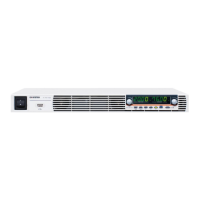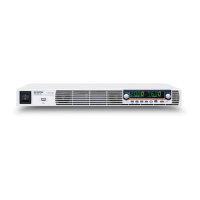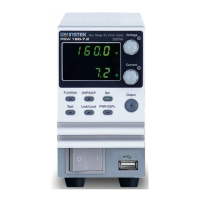Do you have a question about the GW Instek PSU 60-25 and is the answer not in the manual?
Explains symbols used in the manual and on the instrument for safety identification.
Provides general safety recommendations for operating and handling the PSU unit.
Details safe procedures for cleaning the PSU unit, avoiding liquids and harsh chemicals.
Specifies recommended location, humidity, altitude, and temperature for operation.
Outlines recommended conditions for storing the PSU unit.
Provides instructions for environmentally responsible disposal of the instrument.
Safety precautions specific to using the power cord, especially in the United Kingdom.
Introduces the PSU series lineup, covering different models and their capacities.
Details the key performance, features, and interface capabilities of the PSU series.
Lists standard, factory-installed, and optional accessories included with or available for the PSU.
Describes the PSU's front panel layout and controls.
Explains the PSU's display area and operational indicators.
Explains the ports and connectors located on the rear of the PSU.
Introduces the theory of operation, covering basic principles and concepts.
Compares the operating areas of different PSU models based on voltage and current.
Explains the Constant Current (CC) and Constant Voltage (CV) operating modes.
Details adjustable slew rates for CC/CV modes and the function of the bleeder control.
Discusses user-definable internal resistance and the PSU's alarm functions.
Covers connecting power, powering up, wire gauge, output terminals, and rack mounting.
Details setting protection levels, priority modes, panel lock, and save/recall setups.
Details local and remote sense connections, including connectors and covers.
Guides on connecting and operating multiple PSUs in parallel configurations.
Guides on connecting and operating multiple PSUs in series configurations.
Instructions for managing test scripts for automated testing.
Introduces configuration categories and lists available settings with their ranges.
Details settings for delay, slew rates, resistance, bleeder control, and OCP/V-limit.
Covers USB, GPIB, LAN, and UART settings for remote communication.
Explains factory defaults, version display, and power-on configuration options.
Details trigger input/output configurations and accessing special functions.
Discusses analog control options for voltage, current, and output management.
Lists pin assignments and descriptions for the 25-pin analog control connector.
Explains external voltage and resistance control for output voltage and current.
Explains external resistance control for output current.
Details controlling output on/off and system shutdown via external switches.
Covers monitoring voltage, current, operation status, and alarm status remotely.
Details specifications and usage of isolated voltage/current control and monitoring options.
Step-by-step guide for configuring and checking USB remote interface connection.
Steps to configure and check GPIB remote interface connection.
Details UART connection setup, pinouts, and function checks.
Explains Legacy Multi-Drop and Multi-Drop modes for connecting and controlling multiple PSUs.
Covers Ethernet configuration, web server setup, and socket server setup and testing.
Lists the default factory settings for initial configuration of PSU parameters.
Explains various error messages, normal messages, and interface messages.
Provides detailed technical specifications for output, modes, protection, and performance.
Displays physical dimensions for various PSU models in millimeters.
Declares CE compliance and lists applicable EMC and safety standards.
| Model | GW Instek PSU 60-25 |
|---|---|
| Category | Power Supply |
| Power Rating | 1500 W |
| Voltage Resolution | 10 mV |
| Current Resolution | 10mA |
| Output Voltage | 0 to 60 V |
| Output Current | 0 to 25 A |
| Ripple & Noise (CV) | ≤ 1 mVrms |
| Ripple & Noise (CC) | ≤ 3 mArms |
| Interface | USB, RS232 |
| Display | LED |











